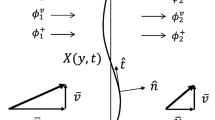Abstract
The process via which a hypersonic boundary layer transitions from laminar to turbulent flow is important in determining the length of transitional flow regions which is important information for designers of hypersonic vehicles. The effects of bluntness of the leading edge of the hypersonic body on the unsteady processes in the transitional region have not received much attention in the literature. This paper compares the unsteady processes in the transitional region for a slender cone with both a sharp and a blunted tip at hypersonic flow conditions in the T4 Stalker Tube. Fewer, more isolated turbulent spots were observed for the blunted than for the sharp cone when tested at similar or higher Reynolds number conditions.
Access this chapter
Tax calculation will be finalised at checkout
Purchases are for personal use only
Similar content being viewed by others
References
S.P. Schneider, Hypersonic laminar-turbulent transition on circular cones and scramjet Forebodies. Prog. Aerosp. Sci. 40(1–2), 1–50 (2004)
K.Y. Lau, Hypersonic boundary-layer transition: Application to high-speed vehicle design. J. Spacecr. Rocket. 45(2), 176–183 (2008)
S. Frauholz, B.U. Reinartz, S. Müller, M. Behr, Transition prediction for scramjets using γ-Reθt model coupled to two turbulence models. J. Propuls. Power 31(5), 1404–1422 (2015)
R.J. Stalker, R.G. Morgan, Free piston shock tunnel T4 – Initial operation and preliminary calibration, CR 181721, NASA, 1988
Jacobs, P. A., Morgan, R. G., Stalker, R. J., and Mee, D. J., Use of argon-helium driver-gas mixtures in the T4 shock tunnel, shock waves @ Marseille, Proceedings of the 19th International Symposium on Shock Waves, ed. by R. Brun and L. Dumitrescu, Springer, Berlin, 1993, pp. 263–268
L.M. Porter, High enthalpy, hypersonic drag measurements on blunt cones in an impulse facility, Ph.D. thesis, The University of Queensland, 1996
D.L. Schultz, T.V. Jones, Heat transfer measurements in short duration hypersonic facilities, AGARDograph 165, AGARD, 1973
K.A. Skinner, Mass spectrometry in shock tunnel experiments of hypersonic combustion, Ph.D. thesis, The University of Queensland, 1994
G.I. Taylor, J.W. Maccoll, The air pressure on a cone moving at high speed – II. Proc. R. Soc. Lond. A Math. Phys. Sci. 139(A838), 278–311 (1932)
G. Simeonides, Generalized reference enthalpy formulations and simulation of viscous effects in hypersonic flow. Shock Waves 8(3), 161–172 (1998)
E.R. Van Driest, Turbulent boundary layers in compressible fluids. J. Aeronaut. Sci. 18, 145–160 (1951)
F.M. White, Viscous Fluid Flow (McGraw-Hill, New York, 1991)
D.J. Mee, Boundary-layer transition measurements in hypervelocity flows in a shock tunnel. AIAA J. 40(8), 1542–1548 (2002)
J.S. Jewell, N.J. Parziale, I.A. Leyva, J.E. Shepherd, Effects of shock-tube cleanliness on hypersonic boundary layer transition at high enthalpy. AIAA J. 55(1), 332–338 (2017)
D.J. Mee, C.P. Goyne, Turbulent spots in boundary layers in a free-piston shock-tunnel flow. Shock Waves 6, 337–343 (1996)
S. Raghunath, D.J. Mee, R. Narasimha, Estimating turbulent spot initiation rates from transition lengths in hypersonic boundary layers. AIAA J., 2017, to appear
Author information
Authors and Affiliations
Corresponding author
Editor information
Editors and Affiliations
Rights and permissions
Copyright information
© 2019 Springer Nature Switzerland AG
About this paper
Cite this paper
Mee, D.J., Raghunath, S. (2019). Boundary Layer Transition Measurements on Sharp and Blunt Cones in the T4 Stalker Tube. In: Sasoh, A., Aoki, T., Katayama, M. (eds) 31st International Symposium on Shock Waves 2. ISSW 2017. Springer, Cham. https://doi.org/10.1007/978-3-319-91017-8_142
Download citation
DOI: https://doi.org/10.1007/978-3-319-91017-8_142
Published:
Publisher Name: Springer, Cham
Print ISBN: 978-3-319-91016-1
Online ISBN: 978-3-319-91017-8
eBook Packages: EngineeringEngineering (R0)




